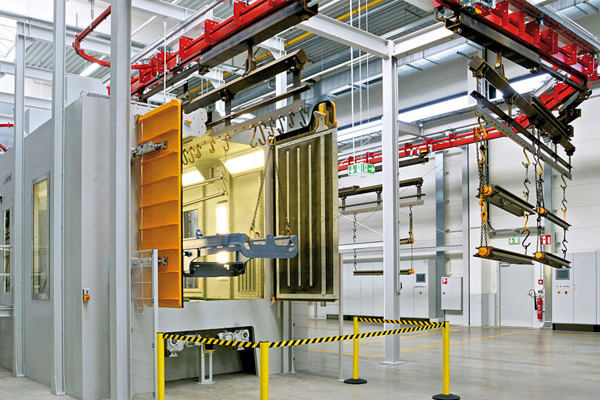AGTOS Continuous overhead rail shot blast machine

The AGTOS Product Range
Our standard program of hanger-type blast machines will comprise six machine sizes.
The choice of the appropriate machine concept depends among other things on the work pieces involved, the required level of performance and last but not least on a customer’s needs regarding an optimized production process.
In the event that a standard model does not meet your surface preparation needs, we will develop a tailor-made blast machine concept for you.
Our team of experts welcomes your detailed questions and looks forward to helping you!
Operation
Work pieces are placed in work piece holders or are suspended directly from the running gear’s rotating hook. The work pieces are then pushed into position in front of the blasting machine. An automatic feed mechanism then advances the work pieces to the first blasting position.
After the blasting program begins, the machine door is automatically closed and electro-pneumatically locked. As the work pieces rotate, they are blasted at three different blasting stations according to the pre-set blasting times.
The blasting abrasive is continuously cleaned, recirculated and reused. An abrasive metering device feeds the cleaned abrasive from the abrasive storage bunker to the high-performance turbines.
Upon completion of the blasting cycle and after the turbines have come to a complete stop, the machine door opens automatically and the suspended work pieces return to their initial position.
A fan unit creates the partial vacuum necessary to maintain dust-free operation of the blasting unit. Extracted air is cleaned in a special filter unit.
Capabilities and applications
Hanger-type blast machines are among the most flexible types of blasting equipment. They are used to remove rust, scale, sand and burrs from many kinds of work pieces. Hanger-type machines are also used for the finish blasting of sensitive work pieces or to roughen work piece surfaces for subsequent coating.
As a rule, hanger-type blast machines are offered either for batch or continuous processing. However, there are many intermediate designs that are oriented towards different kinds of overhead conveyor systems. In many cases, different processes such as blasting, painting and subsequent drying can be interconnected via the overhead conveyor system. This makes it possible to tap an enormous potential for streamlining the process workflow.
Additional processing variants are created by using different kinds of work piece holders to assist in the process of feeding work pieces to the blasting machine. In many cases, standard holders such as disks, baskets or rods can solve the application challenges. However, the increasingly detailed needs of our customers often lead to the creation of tailor-made solutions.




